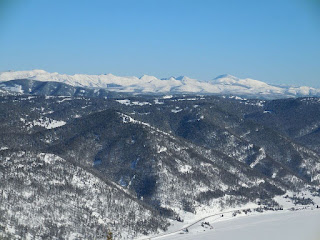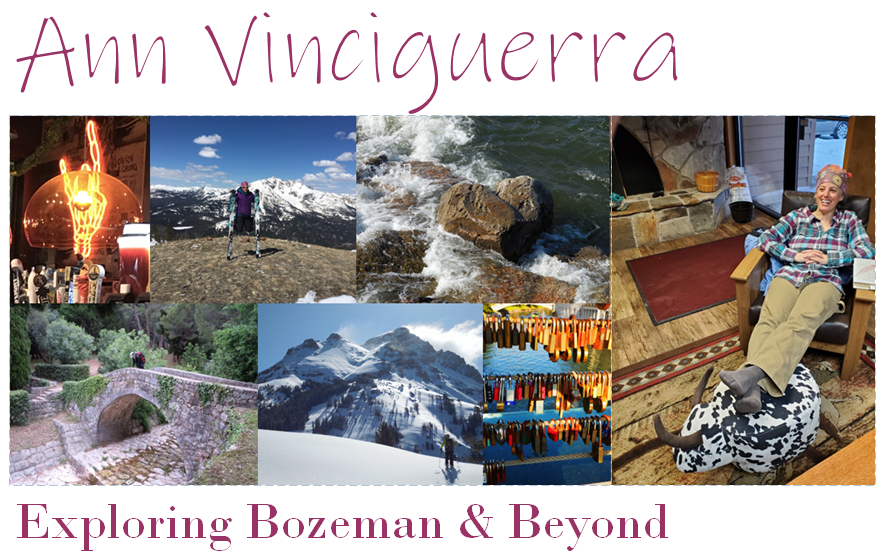 |
| Leaving our mark |
With my ski bum days behind me for the time being, I find that I am eager to get in an extra day of skiing whenever the opportunity makes itself available. Sure, I get out for a short skate ski on the town trails two or three nights a week after work, but that's not the same as putting in a long day in the backcountry.
Seeing as The Man (my employer) had given us a day off for the New Year's holiday, I found myself with a three-day weekend and ready to put in consecutive days of backcountry skiing. Mike and I decided on a road trip and needed to pick from the many options we have available to us within an easy drive from Bozeman. A nice "problem" to have.
After weighing out the pros and cons of each option, we decided upon West Yellowstone, Montana for two nights and three days of skiing. We were considering going to Jackson Hole (It's hard not to consider Jackson when you're planning a backcountry skiing trip), but we've each been there a million times and the shorter driver, lower cost, and lack of crowds tempted us to try West Yellowstone. While this is not exactly a backcountry ski mecca, it offers multiple options for skiing and ended up being perfect. And I must admit, the lack of bro-brahs and overpriced, poseur filled boutique restaurants made it a nice change of pace from other ski destinations.
Here's how it all panned out if you want to try your own backcountry weekend in West Yellowstone.
The Plan: Do some skiing in Yellowstone National Park south of Big Sky on the way down and on the way back, and explore the Hebgen Lake area on the middle day.
The Town: West Yellowstone is similar to many small Montana towns; quite and close to good outdoor activities with just enough lodging and restaurants to make it worth a visit. West Yellowstone is located at the edge of Yellowstone National Park and is a popular snowmobiling and Nordic skiing destination. You can easily walk to the restaurants from most of the hotels in town, and while none of the eateries will rock your world, they have great, friendly service and hearty, reasonably priced food.
The Weather: Historically, West Yellowstone tops the list as coldest spot in the lower 48. If you have an aversion to the cold, this might not be the place for you. With temperatures often plunging below zero, wind, grey skies for days on end, and big piles of snow lining the streets, West Yellowstone winters are the real deal. This is not a town for wimps.
Our Lodging: We stayed at the Stage Coach Inn, which bills itself as a "Western-Swiss" style hotel. With a rustic feel, grand staircase in the lobby and arched roof line, it immediately reminded me of the Wort Hotel in Jackson. Interestingly, my instincts were correct as information in the Inn's welcome packet confirmed that the same folks designed and built both hotels.
I have stayed in a few other hotels in West Yellowstone over the years and found the Stage Coach to be on par with the others. Unlike much of the lodging in town, it is not a chain, which is nice, but my impression is that all hotels in West Yellowstone are of similar quality and price.
The Stage Coach Inn was comfortable and clean with everything we needed for two nights. The
rooms were ample size and included a 'frig and microwave, the lobby was big and comfortable for a lazy evening of reading, and an uninspiring but sufficient continental breakfast was offered in the morning. The Stage Coach also boasts an indoor pool, sauna and small gym, none of which we used, but perhaps the best amenity of of all was that underground parking garage. This made my 16 year old car very happy as temperatures plunged to 15 below the first night and was a warm, wind-free place to put skins on.
The Skiing: To get to West Yellowstone from Bozeman, you'll pass through the Powder Belt, an area along Highway 191 south of Big Sky in a quite corner of Yellowstone National Park. This spot is home to a unique micro-climate that produces more snow than the surrounding areas. As you drive south, you'll notice the snow piles become bigger at around mile marker 27. The apex of snowiness is around Greyling Creek with snow levels beginning to taper off shortly after. I'd say the Powder Belt is approximately between mile marker 15 and 27, give or take a few miles on each end.
Day one and day three found us skiing in the Powder Belt. This area includes a few easy to access spots and a few others for those willing to do more exploring. Day two brought us to Hebgen Lake area, a remote and cold location with a lot of potential for backcountry skiing.This was my second time there and while heightened avalanche danger prevented us from skiing the big face, the skiing was very worthwhile. Lots to explore here and I am scheming to back at some point. All of the conditions and terrain were great and all told, we saw four people in three days of skiing
The Verdict: I had skied each of these areas as day trips from Bozeman, so it was nice to hit them on consecutive days without all of the driving. Overall, West Yellowstone is a great backcountry ski destination. Not a big, exciting one with endless opportunities, but enough opportunities to make it worthwhile. Town has everything you need, and the cold weather and remote location assure that the snow is abundant yet the skiing remains uncrowded. And when you think about it, what more do you need?
Below are some of the best photos from our trip...
~
Seeing as The Man (my employer) had given us a day off for the New Year's holiday, I found myself with a three-day weekend and ready to put in consecutive days of backcountry skiing. Mike and I decided on a road trip and needed to pick from the many options we have available to us within an easy drive from Bozeman. A nice "problem" to have.
After weighing out the pros and cons of each option, we decided upon West Yellowstone, Montana for two nights and three days of skiing. We were considering going to Jackson Hole (It's hard not to consider Jackson when you're planning a backcountry skiing trip), but we've each been there a million times and the shorter driver, lower cost, and lack of crowds tempted us to try West Yellowstone. While this is not exactly a backcountry ski mecca, it offers multiple options for skiing and ended up being perfect. And I must admit, the lack of bro-brahs and overpriced, poseur filled boutique restaurants made it a nice change of pace from other ski destinations.
Here's how it all panned out if you want to try your own backcountry weekend in West Yellowstone.
The Plan: Do some skiing in Yellowstone National Park south of Big Sky on the way down and on the way back, and explore the Hebgen Lake area on the middle day.
The Town: West Yellowstone is similar to many small Montana towns; quite and close to good outdoor activities with just enough lodging and restaurants to make it worth a visit. West Yellowstone is located at the edge of Yellowstone National Park and is a popular snowmobiling and Nordic skiing destination. You can easily walk to the restaurants from most of the hotels in town, and while none of the eateries will rock your world, they have great, friendly service and hearty, reasonably priced food.
The Weather: Historically, West Yellowstone tops the list as coldest spot in the lower 48. If you have an aversion to the cold, this might not be the place for you. With temperatures often plunging below zero, wind, grey skies for days on end, and big piles of snow lining the streets, West Yellowstone winters are the real deal. This is not a town for wimps.
 |
| Who knew a parking garage could be such a luxury?! |
I have stayed in a few other hotels in West Yellowstone over the years and found the Stage Coach to be on par with the others. Unlike much of the lodging in town, it is not a chain, which is nice, but my impression is that all hotels in West Yellowstone are of similar quality and price.
The Stage Coach Inn was comfortable and clean with everything we needed for two nights. The
 |
| The Wort Hotel's Cousin |
The Skiing: To get to West Yellowstone from Bozeman, you'll pass through the Powder Belt, an area along Highway 191 south of Big Sky in a quite corner of Yellowstone National Park. This spot is home to a unique micro-climate that produces more snow than the surrounding areas. As you drive south, you'll notice the snow piles become bigger at around mile marker 27. The apex of snowiness is around Greyling Creek with snow levels beginning to taper off shortly after. I'd say the Powder Belt is approximately between mile marker 15 and 27, give or take a few miles on each end.
Day one and day three found us skiing in the Powder Belt. This area includes a few easy to access spots and a few others for those willing to do more exploring. Day two brought us to Hebgen Lake area, a remote and cold location with a lot of potential for backcountry skiing.This was my second time there and while heightened avalanche danger prevented us from skiing the big face, the skiing was very worthwhile. Lots to explore here and I am scheming to back at some point. All of the conditions and terrain were great and all told, we saw four people in three days of skiing
The Verdict: I had skied each of these areas as day trips from Bozeman, so it was nice to hit them on consecutive days without all of the driving. Overall, West Yellowstone is a great backcountry ski destination. Not a big, exciting one with endless opportunities, but enough opportunities to make it worthwhile. Town has everything you need, and the cold weather and remote location assure that the snow is abundant yet the skiing remains uncrowded. And when you think about it, what more do you need?
Below are some of the best photos from our trip...
 |
| Day One - Skinning out of the inversion |
 |
| Our objective for day two |
 |
| Views from day two |
 |
| Perfect activity partner |

No comments:
Post a Comment